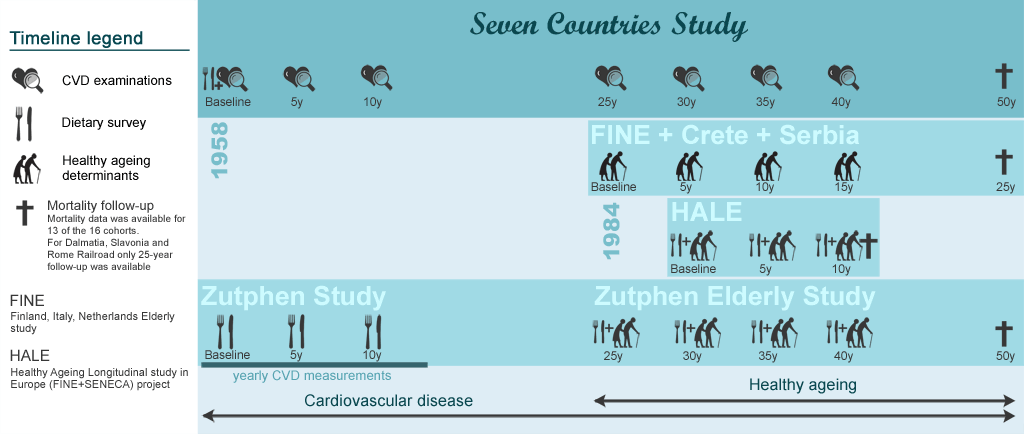Study design of the Seven Countries Study
How was the study originally designed?
The original design of the Seven Countries Study entailed comparing cultures in the different countries through examinations of one or more cohorts per country. The cultures themselves could be compared by measuring the average values of a given factor in the cohorts
Part 1: Risk factors and coronary disease within and among cultures during the first 25 years
Each cohort in the Seven Countries Study showed the characteristics representative of its culture. Because all factors measured were in relation to coronary heart disease (CHD), the risk factors could be compared across cultures. Repeated measures made it possible to study time trends of these factors for each cohort. Also, information on the long-term trends in CHD mortality is available for the various countries. See the trends over time in risk factors and mortality.
The cross-cultural design provided also the possibility to study differences in absolute CHD risk among the 16 cohorts. See the cross-cultural associations.
Using the individual data of each cohort it also was possible to study the strength of the associations for the risk factors in relation to the occurrence of CVD mortality during follow-up in different cultures. See the study findings on risk factors and CVD mortality.
Part 2: Extension of the SCS to studies of healthy aging
After 25 years follow-up, several European cohorts of the Seven Countries Study extended surveys to the collection of gerontologic data relevant to healthy aging. The FINE study (Finland Italy Netherlands Elderly) started in 1984 and surveys were every 5 years up to 1999. Similar surveys were carried out in the three Serbian cohorts and in Crete. The FINE data were merged with those of SENECA, the study on Nutrition and health in the European elderly and in the HALE project (Healthy aging Longitudinal study in Europe). The focus in these added studies was on diet, lifestyle, and risk factors in relation to healthy aging rather than specifically CHD. Read more about the healthy aging studies.
In the early phase of the SCS the mortality follow-up was continued beyond 25 years in all cohorts, with the exception of the two cohorts from Croatia and the Rome railroad cohort. Currently, the 50-year mortality data are being collected in the remaining 13 cohorts.
Part 3: The Zutphen Study was unique in collecting longitudinal risk factor and dietary data
The Zutphen study was the only cohort of the SCS in which yearly risk factor data were collected between 1960 and 1973. Also, seven dietary surveys took place, three surveys between 1960 and 1970 and four between 1985 and 2000. Read more about the Zutphen Study.
Timeline

